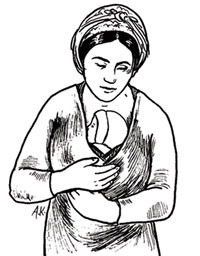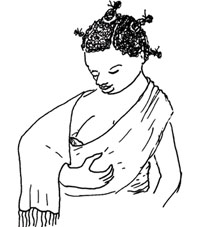2.5.4 Kangaroo mother care (KMC)

Kangaroo mother care has three main components. KMC is also covered in Study Session 8 of the Postnatal Care Module; however as it is such an important aspect of newborn care we have also included it in this study session. You will also learn more about KMC in your practical skills sessions.
1 Continuous skin-to-skin contact between the baby’s front and the mother’s chest: skin-to-skin contact starts at birth and is continued day and night. There may be brief interruptions such as when the baby is being bathed. The baby wears only a hat or cloth, to keep its head warm, and a nappy/diaper (see Figure 2.7).

2 Exclusive breastfeeding: the baby breastfeeds within one hour after birth and then every two to three hours (see Figure 2.8). The baby is unlikely to be able to suck the breast properly so you will need to support the mother to express milk so that she can also cup feed her baby.
3 Support to the mother: the mother can continue to do what she normally does while providing KMC, for example cook, clean and sleep. However she needs support from you as the health worker, as well as her family and others in the community; by keeping the baby skin-to-skin for short periods while the mother rests or takes care of other duties.
How does KMC help the baby and the mother?
2.5.3 Treatment for low birth weight babies
